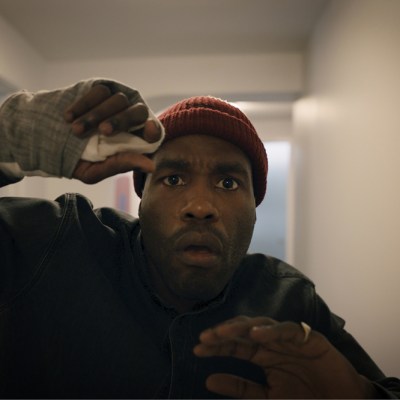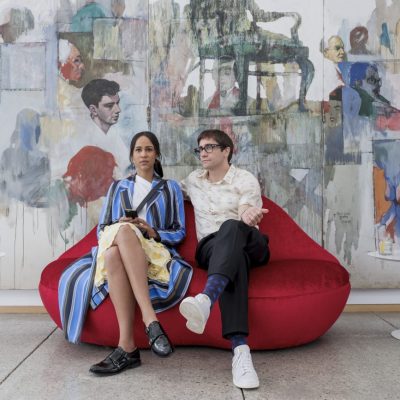Rebecca Sonnenshine’s spooky new Netflix series Archive 81 has at its centre a modern mystery: a collection of fire-damaged video tapes. Film conservator Dan (Mamoudou Athie) is offered the job of restoring these tapes by Virgil Davenport (Martin Donovan), owner of LMG, a shadowy corporation. The tapes were made in 1994 by NYU postdoctoral student Melody Pendras (Dina Shihabi), who was composing an oral history of the Visser Building, a New York apartment block. In the course of this project the Visser burned down, killing Melody and many other residents.
The pay for this curious job is very generous, but Dan must work in complete isolation, in a strange modern compound in the middle of nowhere. As he methodically restores and digitises the tapes, the action divides between 1994 and the present day. There is, of course, something sinister going on in both periods. The Visser is a very strange place to live. Eerie chanting, heard through the air conditioning, alerts Melody to the existence of a cult that meets in the community room; the block was previously the site of an ill-omened mansion, which also burned down; it also has connections to an artistic movement called the Spirit Receivers, whose members believed they could communicate with other worlds and had a relationship with a comet called Kharon, after Charon, the ferryman of the Styx. Meanwhile, in the present day, Dan almost immediately discovers that Melody’s story is connected to his own haunted past, and he becomes subject to troubling visions.
The malign apartment building is familiar horror territory, a downtown cousin to the classic haunted house. In Roman Polanski’s Rosemary’s Baby (1968), Rosemary (Mia Farrow) is menaced by the other residents of Renaissance-style block The Bramford – and more malevolent forces. More exotic is Dana Scully’s (Sigourney Weaver) home in Ivan Reitman’s Ghostbusters (1984). As Raymond Stantz (Dan Ackroyd) explains in the film, its architect Ivo Shandor was ‘either a certified genius or an authentic wacko’. Rare elements are embedded in its frame; the rooftop pagoda doubles as a cult’s sacrificial temple; the structure of the roof cap ‘is exactly like the kind of telemetry tracker that NASA uses to identify dead pulsars in deep space’.
Both of those films derive heavy effect from the architecture of their settings. But compared to those characterful landmarks, the Visser building has little distinction. We see very little of the exterior, but it’s definitely not a Beaux-Arts landmark in Central Park West. It’s middle-class mass housing down on its luck. This nondescript quality becomes a kind of alibi or disguise. ‘These old buildings,’ a Visser resident says, brushing away Melody’s question about why a key is needed to get the lift to stop at the sixth floor. The idiosyncrasies of ‘old buildings’ are the vectors of the ominous: sound transfer from other flats, creeping infestations, the closed society of the eccentric, surly longtime residents.
More characterful is Dan’s lonely workplace out in the woods – unnamed in the show, but the exteriors are shot at the house architect Tasso Katselas built for his family in 1964. This is stern but refined modernism, its concrete and geometry softened with warm brick walls; in Archive 81 it is give moody interiors, with long, under-lit hallways of exposed concrete and unpainted drywall. It has a melancholy air – a place that has lost its original purpose and has never grown into another, an unhomely setting for the unheimlich research it hosts. The Visser, however, cultivates unusual loyalty – its residents feel drawn to it, and inspired to make paintings, opera and costumes, conduct seances or systematically record the television.
They are straining to listen, but to what? Art is, in Archive 81, a pathway to try and communicate with the inscrutable subconscious influence that is permeating the Visser. In this, the show has much in common with some other recent horror, such as Nia da Costa’s intelligent update of Candyman (2021), and Dan Gilroy’s splashy, amusing Velvet Buzzsaw (2019). Some of the pieces collected by the Spirit Receivers are affectingly weird: for example, a bowl embedded with human teeth. The paintings produced by Melody’s friend Anabelle (Julia Chan) are more conventional horror-art fare, in what we might call the vernacular demonism or post-possessionism style: heavily scribbled chiaoscuro revealing ghostly recurring faces. The function of this art is like the function of the tapes. It is to reveal, in a fragmentary way – to tell, but be elliptical. It is to be mysterious.
A mystery, once created, cannot be left intact for long without frustrating the audience. It’s a valuable narrative resource, but not a sustainable one. However, the satisfaction of finding out things and answering questions can be short-lived and anticlimactic against the more evocative and lasting pleasures of not knowing. Keeping a mystery interesting is a delicate business, and the creators of the weird and supernatural have a number of strategies open to them. They can stay short and leave the audience with the mystery largely intact – that’s why so many of the most famous names in the genre are known for short stories, rather than novels. But with eight hour-long Netflix episodes to fill, that’s not an option. So, in longer formats, they play the mystery out, ensuring that each step toward resolution opens up new mysteries. Even this can’t be carried on forever, or you end up with Lost (2004–10), groaning and creaking under its accumulated question marks.
Archive 81 started out as a podcast, created by Dan Powell and Marc Sollinger. Podcasts are a withholding form of entertainment, notorious for drip-dripping just enough intrigue or resolution out in each instalment to keep the listeners going. Fortunately, in the television version, the found footage conceit makes a good frame for slow, steady revelation, dependent as it is on painstaking conservation work, and much helped by Athie’s compelling portrayal of the haunted, miserable Dan. Sonnenshine’s pacing is mostly spot on, expanding our knowledge of what is happening at the Visser without letting too much of the enigma at its heart bleed away, or cheapening the established elements. It fumbles badly in its denouement, forgetting its own rules and wading into a fish farm of red herrings. This is a shame, but only because the preceding episodes are so rewarding, making it well worth your time.
Archive 81 is streaming on Netflix.



